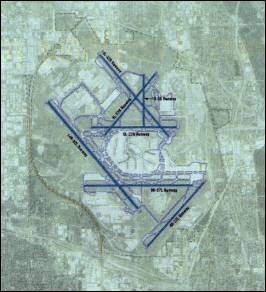P |
hil Condit, chairman and CEO of The Boeing Co., knows a thing or two about the importance of infrastructure to economic development. After all, without the airports and transport systems providing access to them, his global, multi-billion dollar aerospace company wouldn’t be around.
“Economic growth follows infrastructure,” Condit told members of the Economic Club of Chicago in remarks given April 18th; Chicago is Boeing’s new home town, following its headquarters relocation from Seattle in 2001 (see the Site Selection cover story, September 2001). “If this premise is correct — and I believe that it is — it leads to a critical conclusion: If a city or a region is to have a strong, vibrant economy, it needs a strong, integrated infrastructure. That means reliable, interdependent, efficient transportation and communication systems.”
Condit’s inclusion of communication systems in an area’s expanding infrastructure — whether that expansion involves airports, sea ports or other structures, all three of which are the focus of this report — is worth bearing in mind when evaluating locations. Whether or not an area’s long-term growth strategy incorporates a clear communications component that complements structural plans is a more-than-valid criterion in any site search.
“Today, air transportation is absolutely essential to all cities,” noted Condit. “So if cities are to have vibrant economic growth, air, sea and land transportation systems, then equally important is a communications structure. However, to be truly efficient, these infrastructures of transportation and communication must operate not as separate modes but as an integrated set. Today, I believe, they must work together, and this is a huge challenge.”
“All infrastructure matters, but the two keys for the economy of the future are advanced telecommunications and airports,” says Paul O’Connor, executive director of World Business Chicago, echoing Condit. “Without them, you can’t get there from here.”
|
Which is just one challenge out of many facing those working to position their areas as centers of business and industry in the future. Local opposition to airport expansion, geographic constraints and funding issues are just a few of the others.
Big Plans in Chicago
“Airports are drivers of the local economy, and here in Chicago, it’s the number one driver of the local economy,” says Hugh Murphy, senior vice president and regional manager in the Staubach Company’s Educational and Municipal Services division, Chicago. Murphy managed both O’Hare and Midway Airports during his tenure with the City of Chicago.
“Many localities hope for the same thing, and in some cases they get it. But you can’t just plunk an airport down in the middle of nowhere and think it will help.” The notion of “build it and they will come” doesn’t work well in this context, Murphy relates. To attract investment to the vicinity of an airport, it is not always necessary to purchase more land. Murphy is working with several airports to gauge their existing assets as potential sites for development.
A $6 billion expansion of O’Hare International Airport is making its way through the maze of city, state and federal channels on its way to becoming reality. One runway would be added to the complex, and three would be relocated. The City of Chicago expects the annual economic benefit to grow $16.4 billion to $19.9 billion. More details of the expansion can be found at modernization.ohare.com/program.htm.
“The World Gateway Project at O’Hare is a $3.5 billion plan that is independent of the main expansion,” says O’Connor. “It includes new terminals, but it will dramatically improve the movement in and out of the airport area. And it will dramatically improve the ability to move air freight in and out of the airport, which is critical.”
Midway Airport southwest of town is in the midst of a major expansion that involves a new, 900,000-sq.-ft. (83,600-sq.-m.) terminal and other facilities. The project to projected to generate 94,000 temporary and permanent jobs and $4 billion in annual benefits to the southwest side of Chicago.
Long-term Growth Is on Track
The drop-off in passenger volumes following Sept. 11 did little to alter long-term airport expansion plans, most experts concur.
“The current lull in air travel is also related to an economic cycle, and once that bottoms out and we start back up the curve, the volumes will grow again,” says Doug Banez, principal consultant at Eclat Consulting, Arlington, Va., which specializes in airports and aviation. “But airports have long-term views, and aviation is definitely a growth business.”
Airports in medium-sized cities are likely to see expansion activity as more air carriers elect to serve cities point to point rather than through hubs.
Buffalo Niagara International Airport recently added 10 new gates to its new terminal, which attracted point-to-point carrier Southwest Airlines. And Connecticut’s Bradley International Airport, serving Hartford and Springfield, Mass., is winding up a $213 million expansion that includes a new 242,500-sq.-ft. (22,500-sq.-m.) terminal and 12-gate concourse building. But brand new airport plans are few and far between.
“While I am doubtful that we will see many brand new airports in the U.S. in the near future, those airports with the best chance for success will be the ones where airport planners work closely with their communities and economic development groups,” says Banez. “To gain support for airport development plans, planners must effectively convey both the direct and indirect benefits of airports to their communities.”
Continue to Page 2
